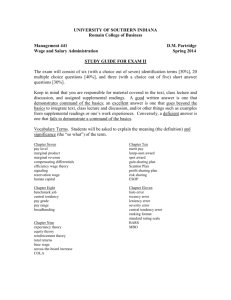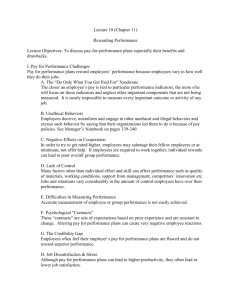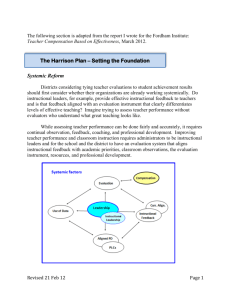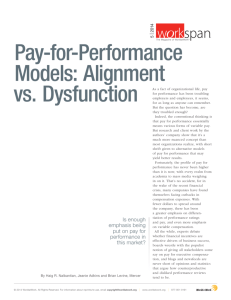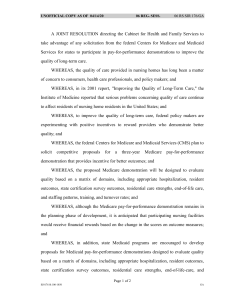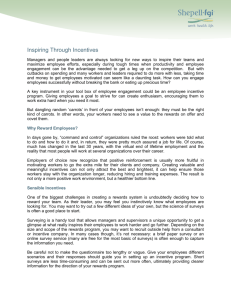Chapter 11
advertisement
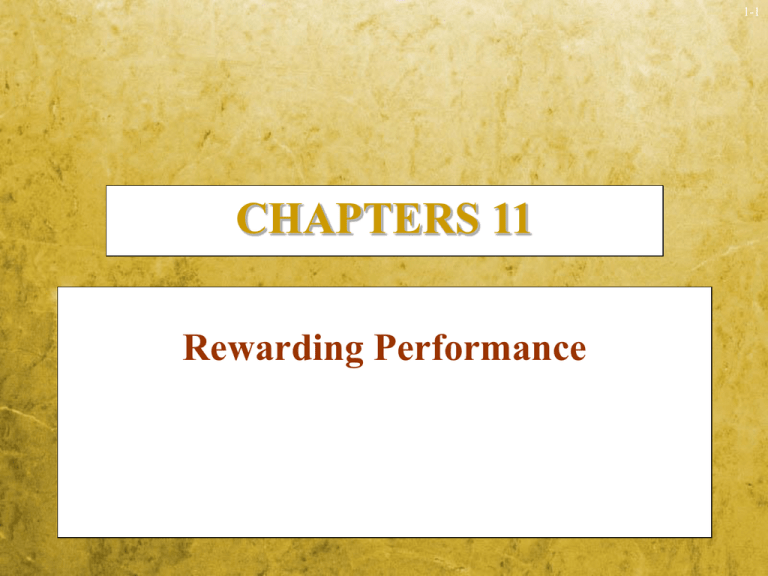
1-1 CHAPTERS 11 Rewarding Performance 1-2 Chapter Objectives Develop pay-for-performance plans that are appropriate for different levels in an organization Identify the potential benefits and drawbacks of different pay-forperformance systems and choose the plan that is most appropriate for a particular firm Design an executive compensation package that motivates executives to make decisions that are in the firm’s best interests Weigh the pros and cons of different compensation methods for sales personnel and create an incentive plan that is consistent with the firm’s marketing strategy Review Key Terms Employee stock ownership plans (ESOPs) Gainsharing Incentives Pay-for-performance Profit-sharing 1-3 Motivation, Performance, and Pay Incentives Financial rewards paid to workers whose production exceeds a predetermined standard 1-4 Individual Differences Law of Individual Differences The fact that people differ in personality, abilities, values, and needs. Different people react to different incentives in different ways. Managers should be aware of employee needs and fine-tune the incentives offered to meets their needs. Money is not the only motivator. 1-5 Needs and Motivation Abraham Five Maslow’s Hierarchy of Needs increasingly higher-level needs: physiological security social (food, water, sex) (a safe environment) (relationships with others) self-esteem (a sense of personal worth) self-actualization Lower (becoming the desired self) level needs must be satisfied before higher level needs can be addressed or become of interest to the individual. 1-6 Needs and Motivation Herzberg’s Hygienes Hygiene–Motivator theory (extrinsic job factors) Inadequate working conditions, salary, and incentive pay can cause dissatisfaction and prevent satisfaction. Motivators (intrinsic job factors) Job enrichment (challenging job, feedback and recognition) addresses higher-level (achievement, self-actualization) needs. The best way to motivate someone is to organize the job so that doing it helps satisfy the person’s higherlevel needs. 1-7 Instrumentality and Rewards Vroom’s Expectancy Theory A person’s motivation to exert some level of effort is a function of three things: Expectancy: that effort will lead to performance. Instrumentality: the connection between performance and the appropriate reward. Valence: the value the person places on the reward. Motivation = E x I x V If any factor (E, I, or V) is zero, then there is no motivation to work toward the reward. Employee confidence building and training, accurate appraisals, and knowledge of workers’ desired rewards can increase employee motivation. 1-8 Pay-for-performance: The Challenges The “do only what you get paid for” syndrome Unethical Behaviors Negative effects on the spirit of cooperation Lack of control Difficulties in measuring performance Psychological contracts The credibility gap Job dissatisfaction and stress Potential reduction of intrinsic drives 1-9 Meeting the Challenges of Pay-for-performance Systems Link pay and performance appropriately Straight piecework: A fixed sum is paid for each unit the worker produces under an established piece rate standard. An incentive may be paid for exceeding the piece rate standard. Standard hour plan: The worker gets a premium equal to the percent by which his or her work performance exceeds the established standard. Use pay-for-performance as part of a broader HRM system Build employee trust 1-10 Meeting the Challenges of Pay-for-performance Systems Promote the belief that performance makes a difference Use multiple layers of rewards Increase employee involvement Stress the Importance of Acting Ethically Use motivation and non-financial incentives 1-11 Employee Preferences for Non-cash Incentives 1-12 Types of Pay-for-performance Plans 1-13 Types of Incentive Plans Individual Sales incentive/recognition programs compensation programs Team/group-based variable pay programs Organization-wide incentive programs Executive incentive compensation programs 1-14 Types of Pay-for-performance Plans Individual-based plans Individual-based plans Advantages Merit pay Bonus programs Lump-sum payments Rewarded performance is likely to be repeated – expectancy theory Financial incentives can shape an individual's goals Help the firm achieve individual equity Fit in with an individualistic culture Disadvantages May promote single-mindedness Employees do not believe pay and performance are linked They may work against achieving quality goals, and they may promote inflexibility. 1-15 Types of Pay-for-performance Plans Individual-Based Plans Conditions under which individual-based plans are most likely to succeed When the contributions of individual employees can be accurately isolated When the job demands autonomy When cooperation is less critical to successful performance or when competition is to be encouraged 1-16 Types of Pay-for-performance Plans Sales Compensation Programs Salary plan Straight salaries Best for: prospecting (finding new clients), account servicing, training customer’s sales force, or participating in national and local trade shows. Commission plan Pay is only a percentage of sales Keeps sales costs proportionate to sales revenues. May cause a neglect of non-selling duties. Can create wide variation in salesperson’s income. Likelihood of sales success may linked to external factors rather than to salesperson’s performance. Can increase turnover of salespeople. 1-17 Types of Pay-for-performance Plans Sales Compensation Programs Combination plan Pay is a combination of salary and commissions, usually with a sizable salary component. Plan gives salespeople a floor (safety net) to their earnings. Salary component covers company-specified service activities. Plans tend to become complicated, and misunderstandings can result. Commission-plus-drawing-account plan Commissions are paid but a draw on future earnings helps the salesperson to get through low sales periods. Commission-plus-bonus plan Pay is mostly based on commissions. Small bonuses are paid for directed activities like selling slow-moving items. 1-18 Types of Pay-for-performance Plans Team-based Plans Team-based plans attempt to support other efforts to increase the flexibility of the work force within a firm. These plans normally reward all team members equally based on group outcomes. Advantages Foster group cohesiveness Facilitate performance measurement Disadvantages Possible lack of fit with individualistic cultural values Free-riding effect Social pressures to limit performance Difficulties in identifying meaningful groups Inter-group competition leading to a decline in overall performance. 1-19 Types of Pay-for-performance Plans Team-based Plans Conditions under which team-based plans are most likely to succeed When work tasks are so intertwined it is difficult to single out who did what When the firm’s organization facilitates the implementation of team-based incentives When the objective is to foster entrepreneurship in selfmanaged work groups 1-20 Advantages and Disadvantages 1-21 Types of Pay-for-performance Plans Plant-wide Plans Plant-wide plans Conditions to be considered Generally referred to as gainsharing programs because they return a portion of the company's cost savings to the workers, usually in the form of a lump-sum bonus. Firm size Technology Historical performance Corporate culture Stability of the product market Three major types: Scanlon Plan Rucker Plan Rewards labor savings, most appropriate for companies that have a "high touch labor" content Most appropriate for organizations that want to improve other variables, such as scrap reduction or energy consumption, in addition to labor. Improshare easiest of the gainsharing plans to understand and install 1-22 Types of Pay-for-performance Plans Plant-wide Plans Advantages eliciting active employee input increasing the level of cooperation fewer measurement difficulties improved quality Disadvantages protection of low performers problems with the criteria used to trigger rewards management-labor conflict 1-23 Types of Pay-for-performance Plans Corporate-wide Plans Corporate-wide Plans Differences between Corporate-wide Plan and Gainsharing macro type of incentive program and is based on the entire corporation's performance no attempt is made to reward workers for productivity improvements they are very mechanistic they may used to fund retirement programs although there are exceptions Profit-sharing plans Cash plans The Lincoln incentive system Profits are distributed to employees based on their individual merit rating. Deferred profit-sharing plans Employees receive cash shares of the firm’s profits at regular intervals. A predetermined portion of profits is placed in each employee’s account under a trustee’s supervision. Employee stock ownership plans (ESOPs) A corporation annually contributes its own stock—or cash (with a limit of 15% of compensation) to be used to purchase the stock—to a trust established for the employees. The trust holds the stock in individual employee accounts and distributes it to employees upon separation from the firm if the employee has worked long enough to earn ownership of the stock. 1-24 Types of Pay-for-performance Plans Corporate-wide Plans Advantages Financial flexibility for the firm Increased employee commitment Tax advantages Disadvantages Risk for employees Limited effect on productivity Long-run financial difficulties. 1-25 Types of Pay-for-performance Plans Corporate-wide Plans Conditions favoring corporate-wide plans Firm size Interdependence of different parts of the business Market conditions The presence of other incentives 1-26 Designing Pay-for-performance Plans Managers and Executives Annual bonus Plans that are designed to motivate short-term performance of managers and are tied to company profitability. Eligibility basis: job level, base salary, and impact on profitability Fund size basis : nondeductible formula (net income) or deductible formula (profitability) Individual awards: personal performance/contribution 1-27 Designing Pay-for-performance Plans Managers and Executives Stock option The right to purchase a specific number of shares of company stock at a specific price during a specific period of time. Nonqualified Indexed option Premium Options stock option priced option have no value (go “underwater”) if the price of the stock drops below the option’s strike price (the option’s stock purchase price). 1-28 Designing Pay-for-performance Plans Managers and Executives Other plans Guaranteed loans to directors Golden parachutes Loans provided to buy company stock. A highly risky and now frowned upon practice Key employee program Payments companies make to departing executives in connection with a change in ownership or control of a company. Performance plans Plans whose payment or value is contingent on financial performance measured against objectives set at the start of a multi-year period 1-29 Designing Pay-for-performance Plans Managers and Executives Creating an Executive Compensation Plan Define the strategic context for the executive compensation program. Shape each component of the package to focus the manager on achieve the firm’s strategic goals. Create a stock option plan to meet the needs of the executives and the company and its strategy. Check the executive compensation plan for compliance with all legal and regulatory requirements and for tax effectiveness. Install a process for reviewing and evaluating the executive compensation plan whenever a major business change occurs. 1-30 Key Strategic Pay Questions 1-31 Why Incentive Plans Fail Performance pay can’t replace good management. You get what you pay for. “Pay is not a motivator.” Rewards punish. Rewards rupture relationships. Rewards can have unintended consequences. Rewards may undermine responsiveness. Rewards undermine intrinsic motivation. 1-32 Implementing Effective Incentive Plans Ask: Is effort clearly instrumental in obtaining the reward? Link the incentive with your strategy. Make sure effort and rewards are directly related. Make the plan easy for employees to understand. Set effective standards. View the standard as a contract with your employees. Get employees’ support for the plan. Use good measurement systems. Emphasize long-term as well as short-term success. Adopt a comprehensive, commitment-oriented approach. 1-33 HR Activities that Build Commitment Clarifying and communicating the goals and mission of the organization. Guaranteeing organizational justice. Creating a sense of community by emphasizing teamwork and encouraging employees to interact. Supporting employee development by emphasizing promotion from within, developmental activities, and career-enhancing activities. Generally committing to “people-first values.”
